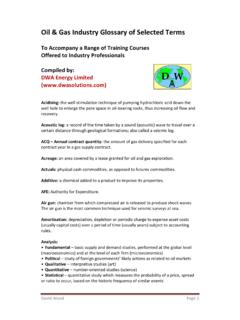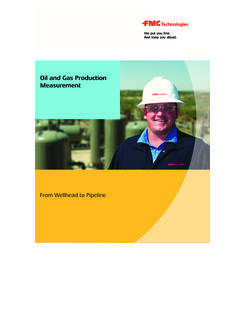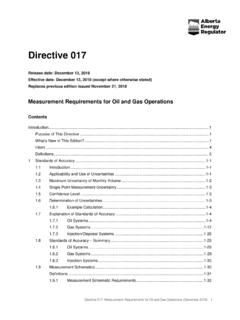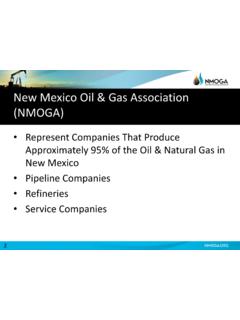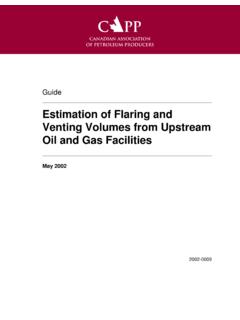Transcription of Oil & Gas Industry Glossary of Selected Terms
1 Oil & Gas Industry Glossary of Selected Terms To Accompany a Range of Training Courses Offered to Industry Professionals Compiled by: DWA Energy Limited ( ). Acidising: the well stimulation technique of pumping hydrochloric acid down the well hole to enlarge the pore space in oil-bearing rocks, thus increasing oil flow and recovery. Acoustic log: a record of the time taken by a sound (acoustic) wave to travel over a certain distance through geological formations; also called a seismic log. ACQ Annual contract quantity: the amount of gas delivery specified for each contract year in a gas supply contract.
2 Acreage: an area covered by a lease granted for oil and gas exploration. Actuals: physical cash commodities, as opposed to futures commodities. Additive: a chemical added to a product to improve its properties. AFE: Authority for Expenditure. Air gun: chamber from which compressed air is released to produce shock waves. The air gun is the most common technique used for seismic surveys at sea. Amortisation: depreciation, depletion or periodic charge to expense asset costs (usually capital costs) over a period of time (usually years) subject to accounting rules.
3 Analysis: Fundamental basic supply and demand studies, performed at the global level (macroeconomics) and at the level of each firm (microeconomics). Political study of foreign governments' likely actions as related to oil markets Qualitative interpretive studies (art). Quantitative number-oriented studies (science). Statistical quantitative study which measures the probability of a price, spread or ratio to occur, based on the historic frequency of similar events David Wood Page 1. Technical quantitative study which attempts to forecast future outright price, differential or ratio behaviour Annual contract quantity: see ACQ.
4 Annulus: the annular space in a well between the drill string or drilling string or production tubing and the well bore or casing. Anticline: a fold in layered rocks originating below the surface in the form of an elongated dome. Anticlines make excellent drilling prospects since any oil will naturally rise to the highest point of the structure because oil has a lower specific gravity than water. API American Petroleum Institute: a US institute created in 1919, which acts as a national trade association and information centre.
5 The API publishes weekly statistics on the petroleum Industry . API gravity: the universally accepted scale adopted by the API for the measurement of crude oil gravity. The scale is calibrated in Terms of degrees API and is calculated using the following formula: API = ( / Specific gravity at 60/60 F) minus This formula allows representation of the specific gravity of oils, which is on the 60/60 F scale (density of substance at 60 F divided by the density of pure water at 60 F). The lighter the crude, then the higher the API gravity will be.
6 Light crudes generally exceed 38 degrees API and heavy crudes are commonly labelled as crudes with API gravity of 22 degrees or below. Appraisal well: well drilled after the discovery of oil or gas to establish the limits of the reservoir, the productivity of wells in it, the properties of the oil or gas and to determine the size and likely yield of an oil or gas field. See development well. Arbitrage: trading the same commodity in more than one market in order to profit from different prices in the markets. Aromatic: organic compound with one or more unsaturated ring molecules with delocalised electrons ( benzene C6H6).
7 They usually have a distinctive odour. Asphalt: a heavy, normally solid, petroleum product. The Terms asphalt and bitumen are interchangeable in the US. Elsewhere asphalt describes the combination of bitumen and aggregate used for road surfacing. Assay (Crude assay): a written laboratory analysis of every defining factor about a crude oil, including yield proportions of each refined product at different heated temperatures, given various refinery configurations. David Wood Page 2. Associated gas: natural gas found in association with oil, either dissolved in the oil or found as a cap of free gas above the oil in the reservoir.
8 Associated liquids refer to liquid hydrocarbons in association with natural gas. ASTM American Society for Testing and Materials: the ASTM sets standards, quality specifications and standard test procedures for determining the quality of petroleum products. Atmospheric distillation: a basic refining process in which crude oil is heated in order to break it down into a number of intermediate components from which finished products can be made. Average daily quantity: a contracted quantity of gas divided by the number of operating days in the specified contract period.
9 Backwardation: a market situation in which prompt physical crude or refined product sells at a premium to forward months' prices for the same commodity. An inverted market ; the opposite of contango. Ballasting: ballasting commences as soon as possible after completion of discharge and final draining. It involves taking ballast (water) into either separate segregated tanks or into cargo tanks. Bare boat charter: a charterer hires a vessel for a long period, appoints the master and crew and pays all the operating expenses.
10 Barge: a vessel used for transporting oil on rivers or in coastal waters. Barges can vary enormously in size, but typically they have a capacity of between 8,000 and 50,000 barrels. Barite (Barytes): a heavy barium mineral used to add weight to drilling mud. Barrel (abbreviated as bbl): a volumetric measurement equal to 42 US gallons or 159. litres. The standard unit of measurement for crude oil and some petroleum products. Barrels per day (abbreviated as bpd, b/d, and bopd for oil): in production Terms , the number of barrels of oil produced from a well over a 24-hour period; in refining Terms the number of barrels input to crude oil processing units or production of a refinery during a year divided by 365 less the downtime needed for maintenance.
